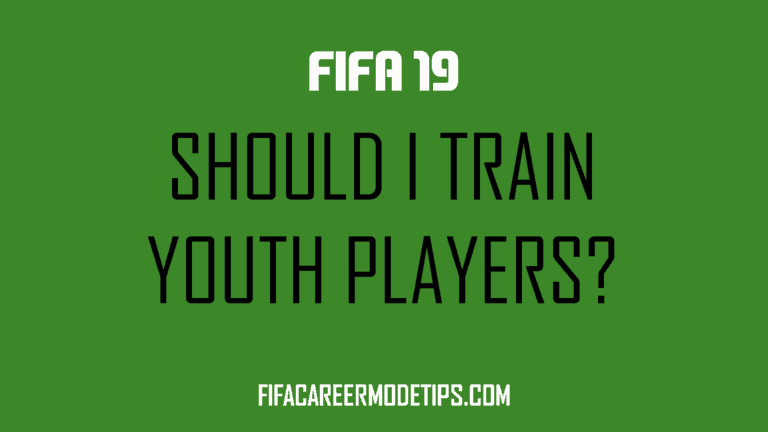
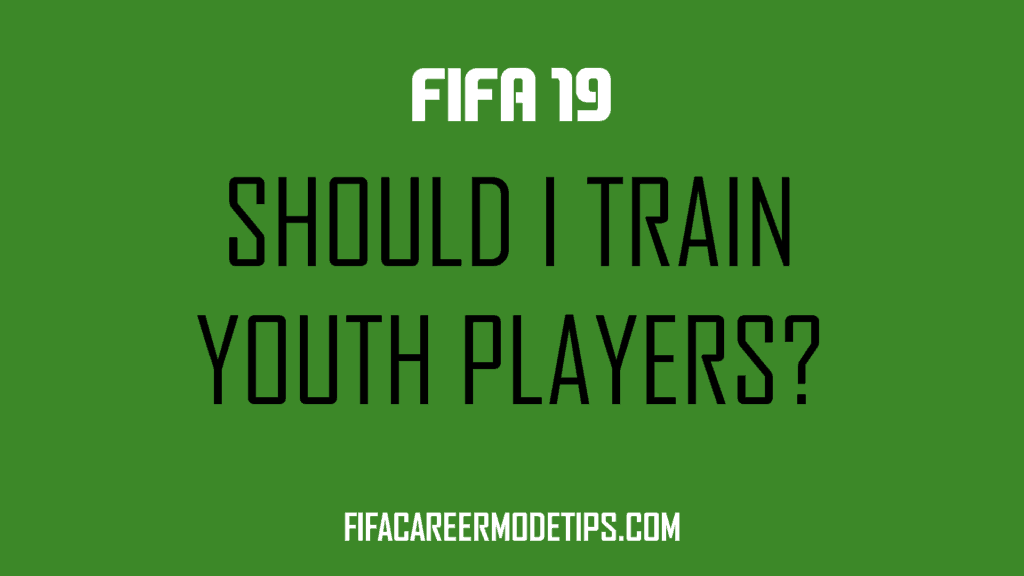
The popularity of our youth scouting guide among other things proves that players love scouting youth players. However, a question we often see is ‘Should I Train Youth Players?‘. There is plenty of ‘common knowledge and anecdotal evidence out in the world, but we wanted to take a scientific approach. If you train youth players, will it have a positive or negative effect? Does training stunt physical stats? Read on to find out.
Experiment
We created a new career mode save and picked a team with enough resources to afford the best scouts. We also had to make sure the squad was strong enough as we would be simming six months at a time. Once we had hired three good scouts, we sent them to work. During that first season, we simply focused on scouting enough promising players. Towards the end of the season, we rejected the less promising players, leaving us with 12. As you’ll see in the next section, they all had good growth potential. We also made sure we had a good mix of positions and player types.
At the start of the next season, we forked the save. One we would sim through without training any players, the other we would train only these youth players on rotation. Although there are many different variables that could affect the outcomes of each, this is as close to a fair test we could get. This meant that in both saves, team selections were down to the ‘assistant manager’. Five training slots per week over 52 weeks is 260 slots, this means each player was getting around 21 sessions per season.
We recorded each player’s stats and attributes at the beginning of the first season and then every January and June after that. Stats and attributes were recorded over the following three seasons.
Players
Here are the twelve youth academy players we used for this experiment. For each one we’ve included all relevant high level information about them.
1. Fernando Monzon
17 year old Goalkeeper. Rated 62 when scouted, 66 at the start of this experiment. Potential range showed as 79-85, then ‘Showing Great Potential’.
2. Brahim Tagmaoui
17 year old Right Winger, Attacker player type. 52 rated when scouted, 55 at the start of this experiment. Potential range was broad at 76-94, later revealed to be ‘Showing Great Potential’.
3. Idris Selmi
17 year old Defensive-Minded Right Back. Rated at 62 when initially scouted, 65 by the time this experiment began. Impressive potential range of 83-94, soon revealed to be ‘Has Potential to be Special’.
4. Jamal Saber
17 year old Physically Strong Centre Back. 52 overall to start with, 55 overall at the start of the experiment. Reasonable potential range of 81-87, later became ‘Showing Great Potential’.
5. Johannes Matson
16 year old Right Winger, Winger player type. Rated 52 overall when first scouted, grew to 56 by the start of this experiment. Potential range was 80-86 and unsurprisingly ‘Showing Great Potential’.
6. Carlos Lins
16 year old Defensive-Minded Left Back. Initially rated at 56 but was 60 overall at the start of this experiment. Less encouraging potential range of 71-85 but thankfully turned out to be ‘Showing Great Potential’.
7. Tyler Williams
16 year old Right Midfielder, with Winger player type. Rated 62 in the beginning, 65 at the start of this experiment. Great potential range of 85-91 and classified as ‘An Exciting Prospect’.
8. Felipe Silvera
15 year old Technically Gifted Centre Forward. Only rated 59 overall initially and only grew to 60 for the start of this piece of analysis. Decent enough potential range of 83-89 which translated to a ‘An Exciting Prospect’ label.
9. Issam Klouchi
16 year old Physically Strong Centre Back. Initial low rating of 52, up to 55 by the time the new season began. Potential range displayed as 78-88 then ‘Showing Great Potential’.
10. Alexander Persson
16 year old Defensive Minded CDM. 52 rated to begin with, 55 overall at the start of the season. His potential range was displayed as 81-87 and later ‘Showing Great Potential’.
11. Evan Bliska
16 year old Technically Gifted CAM. 54 overall initially but 57 rated at the start of this experiment. Reasonable potential range of 78-86 which became ‘Showing Great Potential’.
12. Cong Huang
15 year old Technically Gifted Striker. Rated at 53 overall. Solid potential range of 85-91, which unsurprisingly became ‘An Exciting Prospect’.
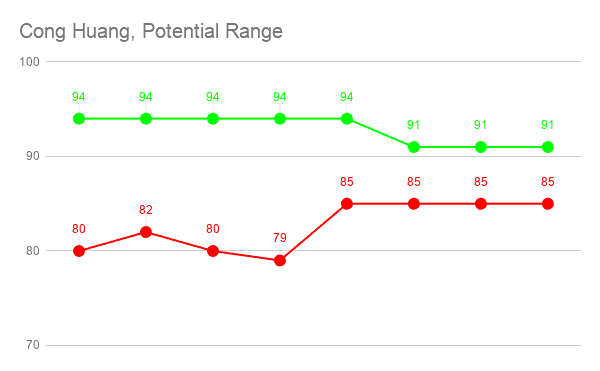
Outcome
Here are the key findings after three seasons.
- Fernando Monzon – 74 OVR (+8) without training, 81 OVR (+15) with training.
- Brahim Tagmaoui – 69 OVR (+14) without training, 76 OVR (+21) with training.
- Idris Selmi – 77 OVR (+12) without training, 80 OVR (+15) with training.
- Jamal Saber – 66 OVR (+11) without training, 76 OVR (+21) with training.
- Johannes Matson – 70 OVR (+14) without training, 77 OVR (+21) with training.
- Carlos Lins – 68 OVR (+8) without training, 75 OVR (+15) with training.
- Tyler Williams – 76 OVR (+11) without training, 78 OVR (+12) with training.
- Felipe Silvera – 69 OVR (+9) without training, 77 OVR (+17) with training.
- Issam Klouchi – 67 OVR (+12) without training, 79 OVR (+24) with training.
- Alexander Persson – 68 OVR (+13) without training, 76 OVR (+21) with training.
- Evan Bliska – 68 OVR (+11) without training, 75 OVR (+18) with training.
- Cong Huang – 67 OVR (+14) without training, 76 OVR (+23) with training.
This means that the average untrained player would grow their overall rating by over 11 points in three seasons, almost 4 points per season. Compared to the average trained player that would grow by over 20 points, or almost 7 per season.
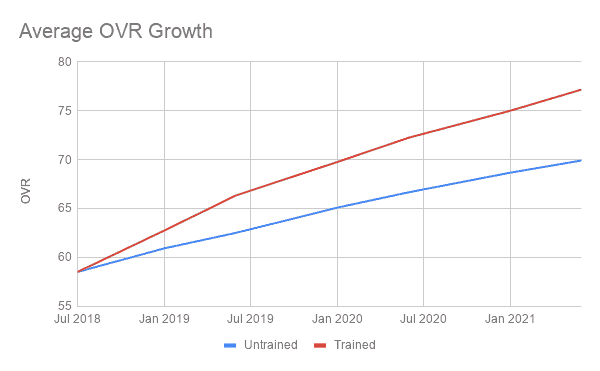
Even after three seasons this is quite a difference. If you were to train youth players over a longer period of time, the gap would be even wider.
Growth
We did notice that certain players were growing faster than others, across both saves. This was interesting, but we came to a fairly obvious hypothesis. The larger the gap between current overall rating and potential, the faster that player will have to grow. Assuming that most youth players are around 18, they have lets say 10 years to hit their peak. A player with 55 overall and 85 potential will likely grow faster than a player with 68 overall and 88 potential, 3 points per season compared to only 2.
To try and prove this, we made a custom calculation and plotted the results on a graph. Firstly, we worked out each player’s average attribute growth points for a half season, with no training.
Then we gave each player a custom value. Firstly we worked out the difference between their initial overall and their predicted potential. Then we divided this by the number of years left before they reach a predicted peak age.
These two values were plotted against one another on the following graph.
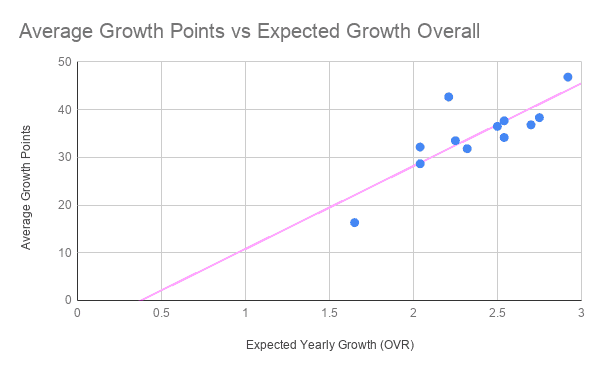
The data points on the graph (with the assistance of a trendline) show positive correlation between these two values. This seems to support the idea that faster growth will be seen in players that have a long way to achieve their potential.
Appearances
Another assumption we’ve always had is that giving youth players game time is a good way to help them grow. Because we also recorded the number of appearances each player made, we were able to plot these against the number of growth points. As this blog is about whether or not to train youth players, we separated the data from each save and created two graphs.
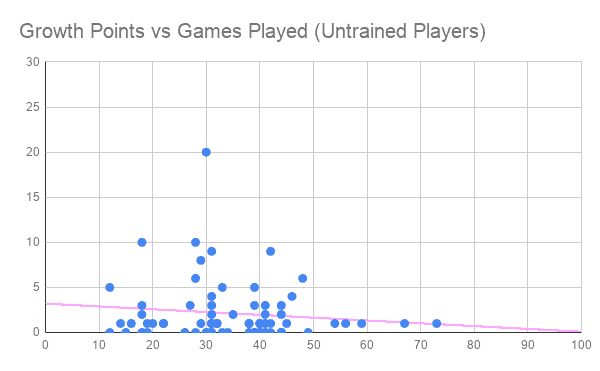
Because the players are lower rated, they’re unlikely to be picked to play very often. This meant players often only played one or even zero games in a period. Even still, we had enough data points to be confident we’d see a pattern if there was one. The graph doesn’t actually seem to suggest that more game time leads to higher growth in players.

This graph for players that were trained tells a similar story. If anything, the trend lines for both suggest negative correlation. More appearances somehow results in less growth in a given period.
While this is a little surprising, the mechanics behind this are probably a little more nuanced. Instead of appearances, it is likely that a player’s form can affect their growth.
Attributes
This was one of the key areas we were interested in. While FIFA career mode is a game based on numbers, it’s common to hear anecdotal evidence. You’ll often hear that when you train youth players, it negatively impacts their physical attributes. While we would agree with this anecdotally, we wan’t to see if the numbers supported that theory.
We pulled together the data for the outfield players only, and compared the average attributes of a trained player with an untrained player.
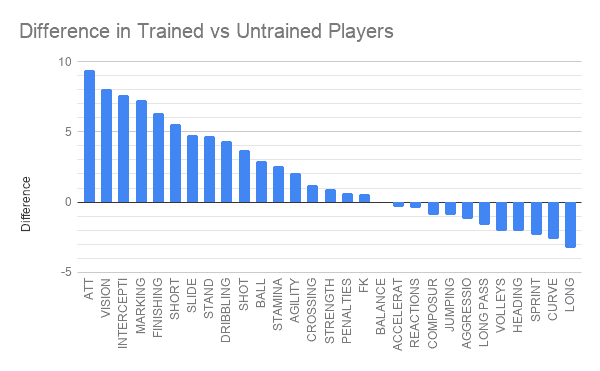
Unsurprisingly, the graph skews towards the positive. This was expected as trained youth players outgrew untrained players significantly. The attributes that were positively affected by training were things like Attack Positioning, Vision and the defensive attributes. These weren’t a huge surprise as they can be trained for directly via different drills. Stamina seemed to be positively affected, again because it can actually be trained. It was interesting that Agility and Strength are positively affected when you train youth players. Strength is a highly sought attribute, common knowledge suggested that strength would suffer from training.
Balance didn’t appear to be affected either way. Acceleration and especially Sprint Speed seem to be negatively impacted when you train youth players. This supports the assumption but will be disappointing to managers who rely on pacey players*. Reactions, Composure, Jumping and Aggression were also negatively impacted by training youth players. Strangely, Heading Accuracy, Curve and Long Shot seem to be stunted when you train youth players. These can all be trained so this is curious.
Conclusion
So, what did we learn from this? Most obvious and expected was that training helps youth players grow more quickly. Secondly, we learned that player growth is faster when there is a significant difference between their overall rating and potential, provided they have years left to ‘peak’. It was also apparent that game time alone cannot boost player growth, but it’s likely that player form would affect this. Players in good form seem to get bonus growth points at the start of each month. Finally, although trained players are better off overall, some of their attributes will suffer. These do include stats that are considered to be physical and mental, but also some that are technical.
But you’re still wondering…
Should I Train Youth Players?
Our answer is that it depends. If you only ever sim games, then the positives of training outweigh any negatives. Also you’re fine to train youth players if you only intend on raising their OVR and selling them for profit.
If however, you’re a purist and play every game, you might want to avoid it altogether or manage it very carefully. The findings in this blog do seem to support the theory that players have a growth allowance for a given time period. This means that if you use up (or exceed) this allowance by training certain attributes, others won’t be able to grow naturally. Therefore it’s easy to end up with a physically stunted striker if you over-train them and focus only on finishing.
One of the biggest criticism of youth players is that their attribute profiles are often skewed, making them difficult to handle in games. If this is a concern for you, spend time evaluating their strengths and weaknesses. Some occasional training to smooth over their rough spots might be a better investment than intensively training their strengths. Another easy diagnosis is that you might be playing them in the wrong position. Check out our position calculator, often youth players are better suited to a slightly different position.
*It’s worth pointing out that in FIFA 19, you are able to train a player’s sprint speed and acceleration.